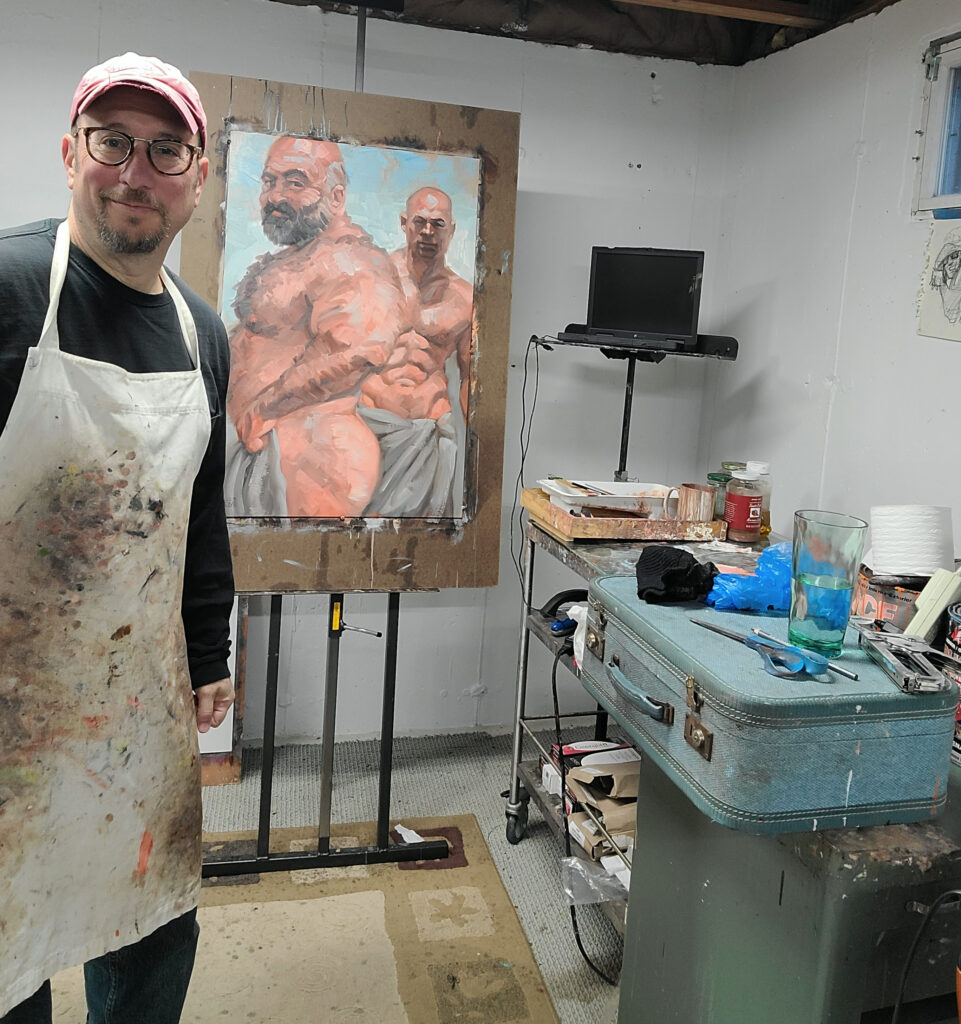
Purpose, Passion and Technique: The Bear- Centric Art of Kenney Mencher
Like most middle-aged bears, Kenney Mencher describes his inner critic as “pretty harsh despite the facts of my existence.”
So what’s his problem?
Mencher goes on to say: “Relatively I’m not very old yet. I’m going to be 59 in February. I guess I’m successful but I’m not a millionaire. I’m a fulltime artist who does well enough for himself that I was able to quit a tenured professorship and not lose too much sleep worrying about my finances and my health. I’m not too far outside of the prescribed BMI and I still get flirted with and even propositioned at times. When I post a selfie, I get positive comments and likes.”
Like most middle-aged men, especially for us bears, society and gay culture has aged us out and raised the bar so high that most men have internalized society’s values as their internal and harshest critic. When confronted with images of young millionaire day trading jocks on their meteoric rise in the shows and novels we consume sometimes we lose sight of how successful, attractive, and beautiful all of us are. That’s where Mencher’s art comes in with his message of body positivity and self-acceptance. Mencher describes himself as on a mission to “represent the underrepresented in art. I want to help show the beauty of all men and my particular focus is on older, heavier, hairier, middle-aged men. Not just the muscle bears but also the slightly average cuddly variety that I fall in to.”
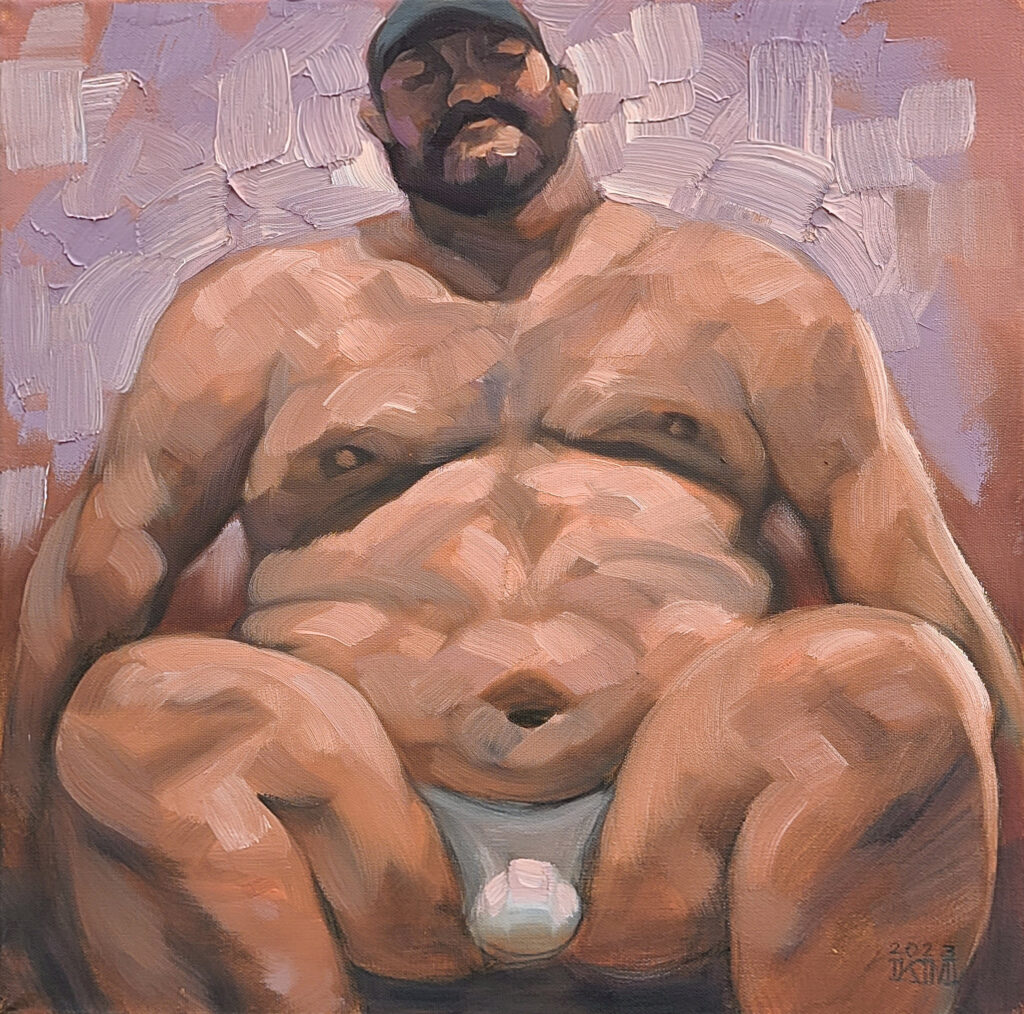
His painting Couch Jock is based in the tenets of the “body positivity” movement. Body positivity refers to the assertion that all people deserve to have a positive body image, regardless of how society and popular culture view ideal shape, size, and appearance.
“For years I had trouble accepting my body as I aged. So, I began to paint people who looked more like me, and I realized I wasn’t alone when I discovered other bears and the concepts behind ‘body positivity.’”
Some of the goals of the body positivity movement include:
• Challenging how society views the body
• Promoting the acceptance of all bodies
• Helping people build confidence and acceptance of their own bodies
• Addressing unrealistic body standards
Mencher often works in a traditional manner of oil painting using techniques he learned as a teenager studying with Max Ginsburg and Irwin Greenberg at the High School of Art and Design, in the Art Student’s League. Most of the time he paints using a technique that Caravaggio first made popular in the 1600’s called the alla prima method. Often the paintings are made without preparatory drawings or even drawings on the canvas. The under drawing is made with a brush into a soupy mix of burnt sienna and the lights are wiped out and the paint is then quickly and thickly dashed into the tonal study.
Alla prima is an Italian phrase that means ‘at first attempt’. It refers to a wet-on-wet approach whereby wet paint is applied to previous layers of still-wet paint, often in a single sitting. Over the years, the technique has been adopted and adapted by artists from Van Gogh to Velázquez.
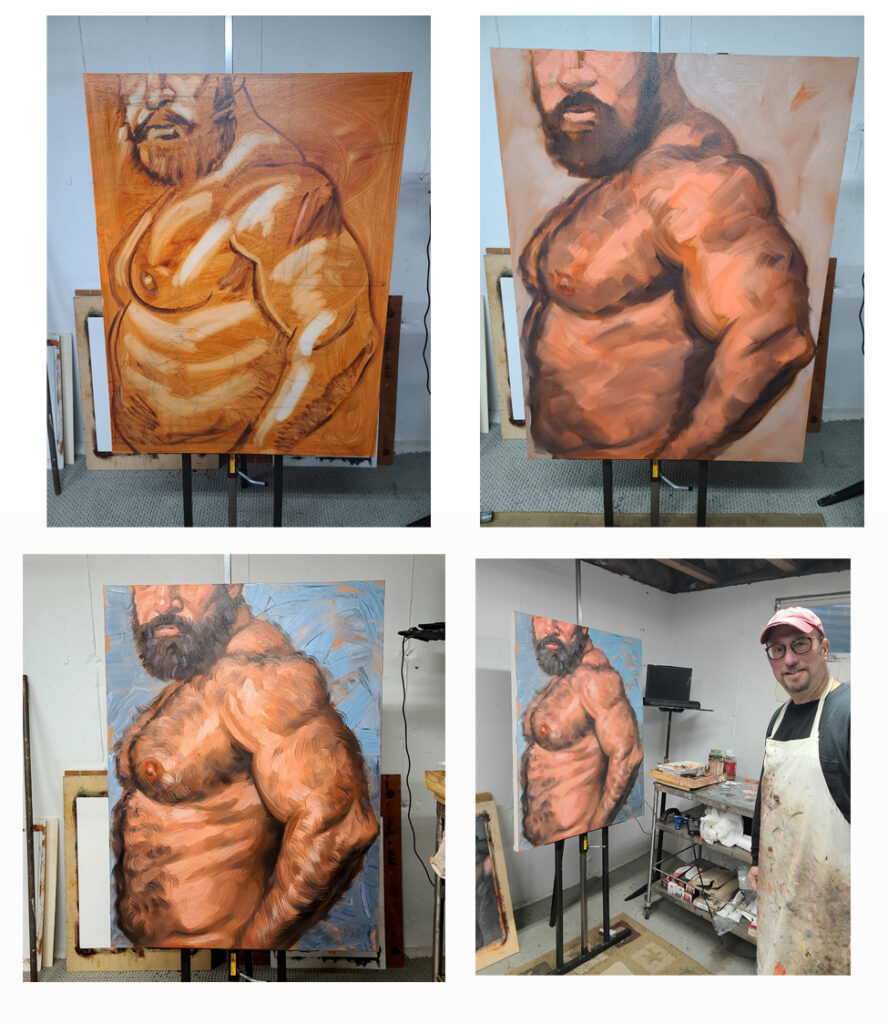
Mencher’s Captain Ursine is a monumental painting is of a monumental bear. “One of the things that I like to do is play around with identity, body positivity, and the formal aspects of painting such as composition color and texture. I like to paint bears and older men in general who have thicker body types and a lot of body hair because that’s who I relate to the most and it also reflects my body type and even my level of hairiness. However, I’m not as muscular and powerful looking as this older male is. The mission that I have with my painting is to help older men like myself accept their bodies and to promote body positivity.”
In terms of the painting’s composition, one of the things Mencher likes to do is to eliminate as much negative space as possible and to devote as much of the painting to filling up the composition or picture plane as he can. Another way that he does this is to have the figure touch or “kiss” the four edges of the canvas to make a sort of interesting spiral composition. This also aids a little bit in cropping out some of the things that would identify the model specifically such as the top part of his face. “I wanted the viewer to identify with the model without necessarily identifying who the person is specifically” he explained.
“Textures is a big part of my painting and it’s one of the more abstract qualities. If you look closely at the painting, you’ll see that the body is rendered mainly with brushes and thick impastos of paint. The term “impasto,” literally translates from the Italian as the word paste and it is an art historical term to describe thick layers of paint. I set off the brushwork of the body with thick troweled on paint in the background. The hair on the body has been accomplished with a series of coarser bristle brushes and with matching some of the hairs into the thick paint on top.”
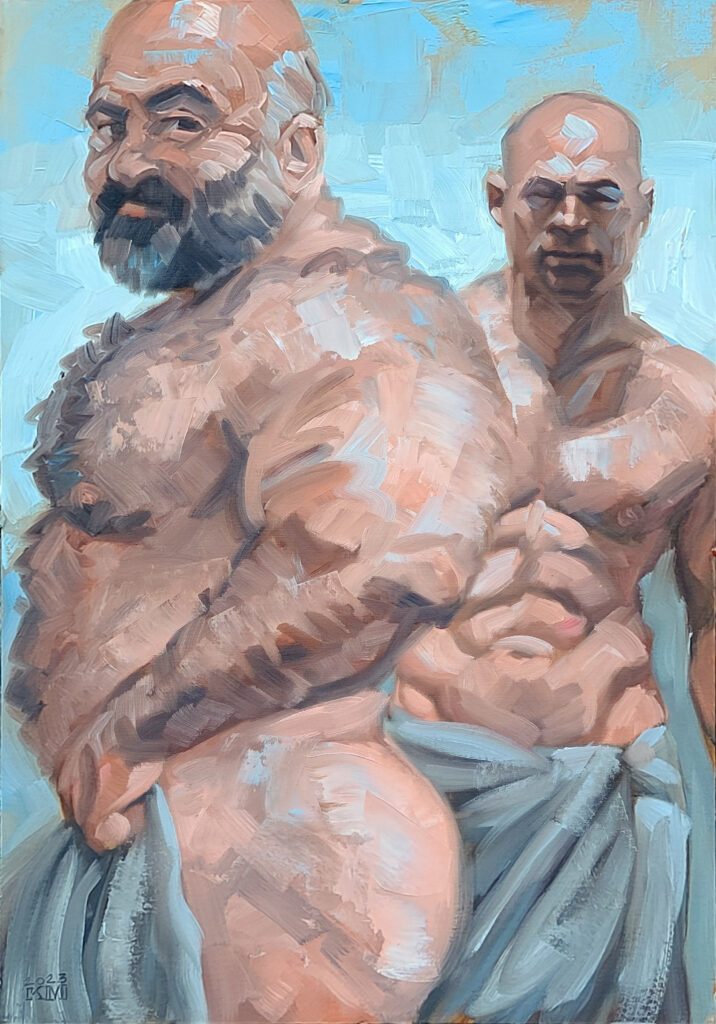
Kenney also likes to explore relationship and interpersonal dynamics with his work. Take Conserving Water for instance:
“I was hoping to tell a story in this painting. In gay culture, especially before the advent of the AIDS epidemic, bathhouse culture was an integral part of gay life. It’s slowly starting to make a comeback, and one of the things that is also changing in terms of bathhouse culture is an approval of and attention to body positivity, especially in reference to older men and those who describe themselves as bears. Another part of this is even that there are so-called “bear chasers.” In this painting I was playing with the idea of both of those elements. The handsome jock wrapped in his towel and the older more powerful bear looking playfully out at the viewer.”
Mencher likes to draw and uses drawings both to experiment and to make studies for oil paintings as well.
“I tried to draw as much as I can. Most times I spend my days working on oil paintings in my studio. However, I spend a lot of time in the evenings drawing as I watch TV and listen to music or audiobooks. I use a light fast black crayon to draw rather than a pencil, mainly because pencil can smear more easily and the same goes for working with charcoal. I’ve found that working with crayon makes the drawing much more durable and less susceptible to getting smudged or damaged, especially during shipping. I also draw on a super heavy cotton fiber paper called Rives BFK. It’s kind of an expensive paper because it’s supposed to be used for printmaking and it’s made from cotton rather than wood pulp. This makes it feel deliciously thick and sturdy almost like the same paper that used to make money.”
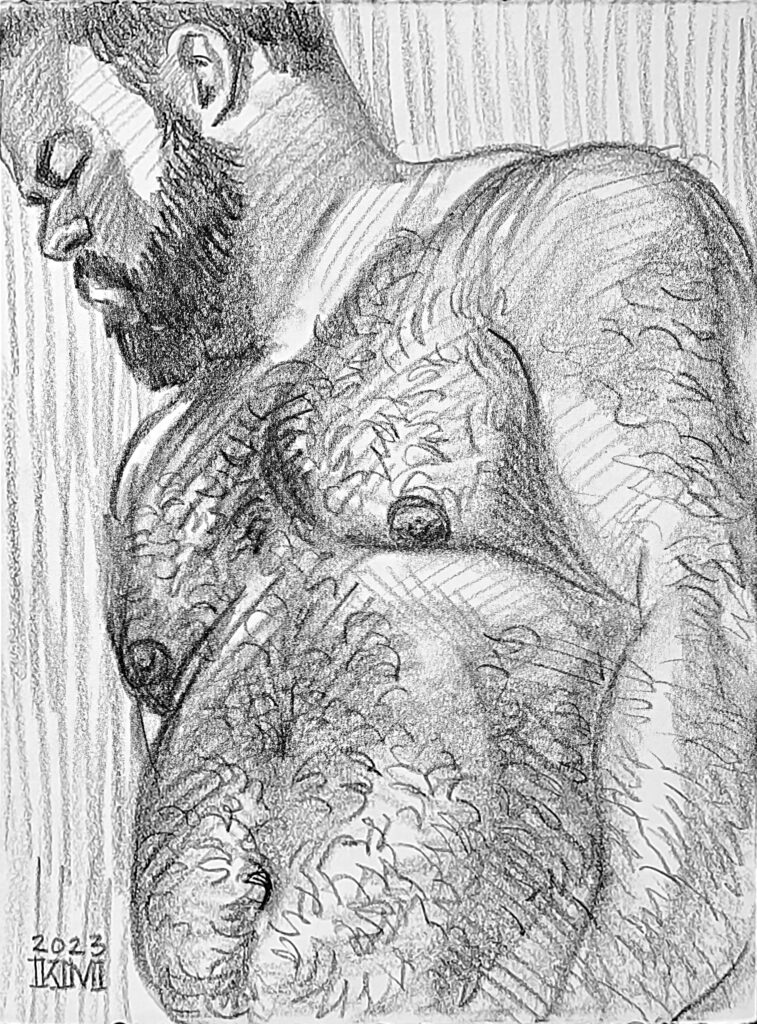
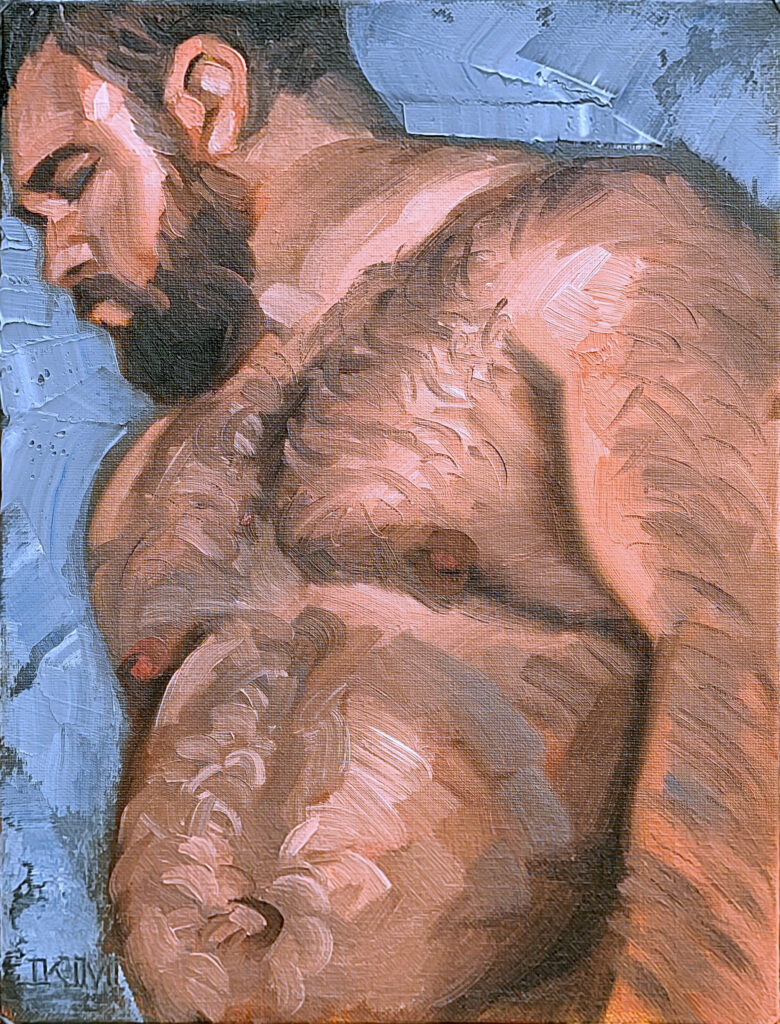
He continues “Drawing is the way that I started painting but it’s also a way that I allow my imagination to run free and experiment with different subjects, techniques, and composition. In this drawing, I was working with the rule of thirds, which is a compositional concept in which you try to create an asymmetrical composition by placing the subject or focus of the composition in one of the corners of the page rather than in the center.
I also played with composition by cropping as well as shifting the subject matter to the edges of the page. Often, I like to have the figure “kiss” or touch the edges of the picture rather than float free in the center.”
The idea of relationships and even the old-fashioned notion of “cruising” in the late 70’s and early 80’s just before the AIDs epidemic is very prevalent in his work as almost a nostalgic nod to Mencher’s days growing up in New York. Mencher describes being a junior in high school and heading down to the village with his friend Johnny where they cruised older men and occasionally snuck into (and were often thrown out of) bars on Christopher Street. This is a jumping off point for paintings with more of story or “narrative” as he calls it.
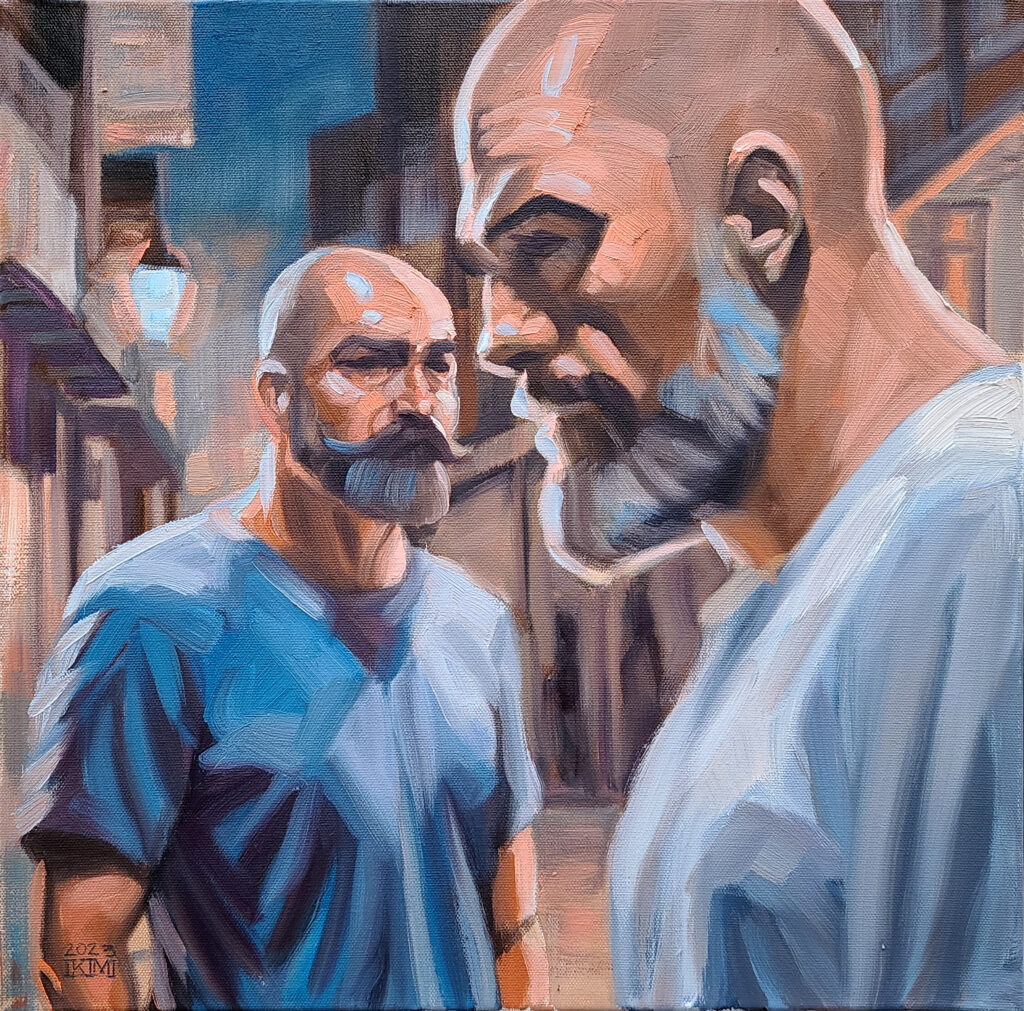
“I’m obsessed with painting and trying to improve my art. Two Men in an Alley is part of a series of paintings where I’m trying to bring my work up a level in terms of the subject matter and the physical qualities of the painting itself. Most of my paintings are usually a single figure in a very limited environment. In this case, I thought it might be more interesting and tell more of a story if I had two figures in a setting which allowed one to tell more of a story. In this case, I chose the setting of an alley.”
“I tend to think of the figures in the painting as characters rather than just models” he explains. “I tried to create a distinctive character for each one of the figures that I thought my audience could relate to. Are they a couple? What’s going on here? I wanted the viewer to wonder what they were talking about. I’m hoping that will make up a story.”
Two Men in an Alley is one of a group of paintings that were worked in a more layered approach over the course of two weeks. It began as a rough sketch on the canvas panel that Mencher worked out a little bit more with crayon and then worked out the shading and environment using his imagination.
The next couple of days were spent working on an underpainting that began with his thin washes of oil paint and ended up with thicker more opaque layers. On the last day he worked on this painting he attempted to build up the surface and enhance the textures so that the paint textures would match with the textures of the figures and the environment he was presenting.
Still, probably one of his favorite things to paint is a single figure that communicates who he identifies with the most.
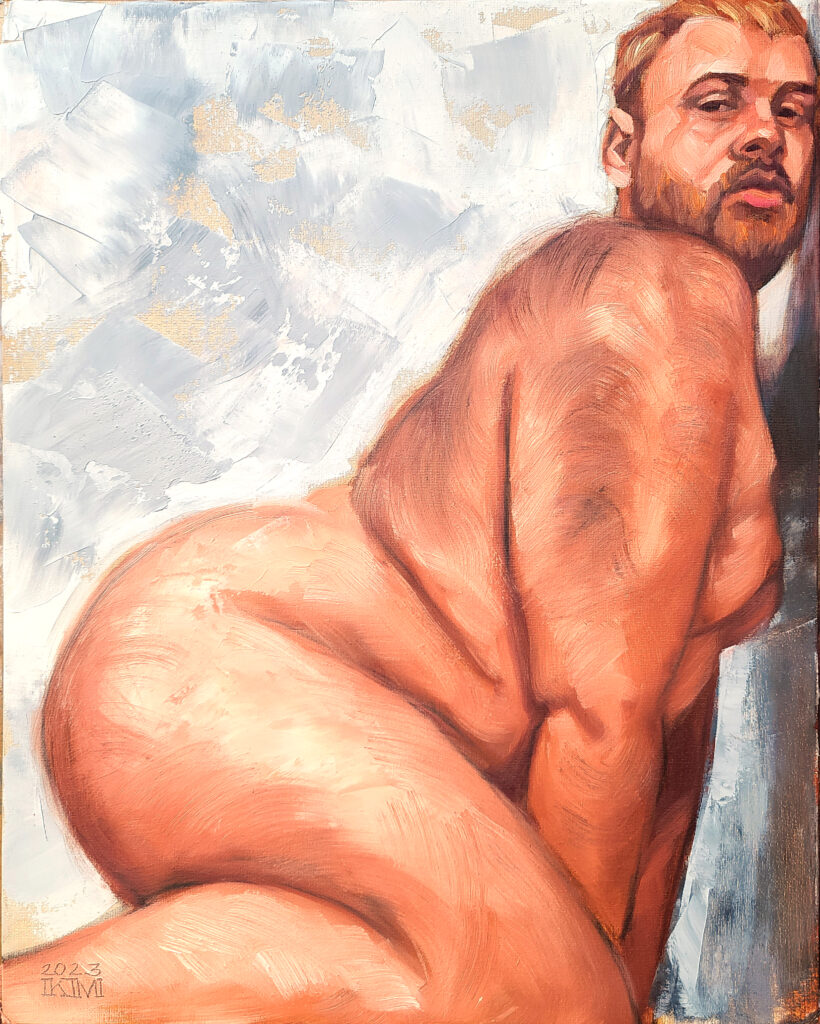
“I try to make well-crafted work about the human figure and the human condition. I focus on the kind of beauty for both men and women that is “non-standard.” I’m most interested in representing people who don’t get represented by mainstream artists. I particularly like painting bears, cubs, and other wildlife. I am not a risqué or sexy kind of guy, however, at times some of my work has been called that. This is only a small part of what my paintings are about. Most of my work deals with the visual translation of familiar ideas.
My images are about points of view, my own and the person who is looking at my work. These images are designed to provoke discussion about the politics of how we see the world. Many images are based on the visual, literary, and spoken clichés that we are inundated with through movies, television, and print media. These paintings indirectly reference how the media forces us to see the world, but even though the media seeks to find a homogenous point of view, we all see things differently. My paintings are ink blot tests, and they beg the question, what’s your point of view?”
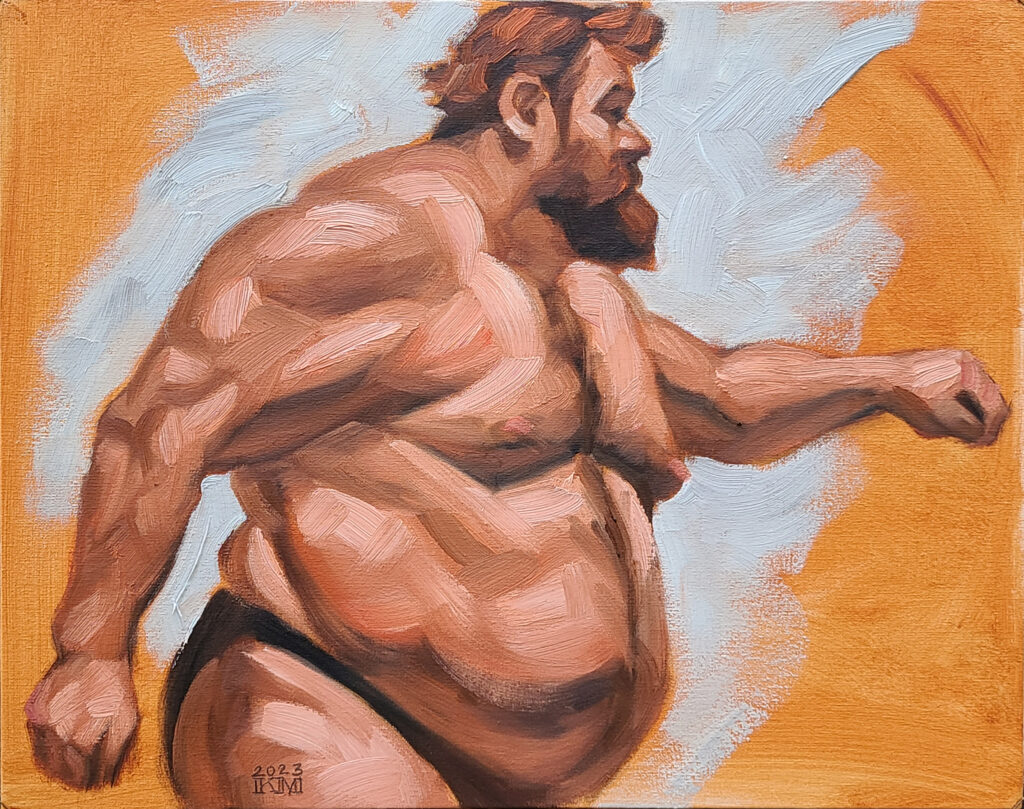
You can visit Kenny Mencher and see more of his art here:
https://www.kenneymencher.com/
https://www.instagram.com/kenneymencher/
